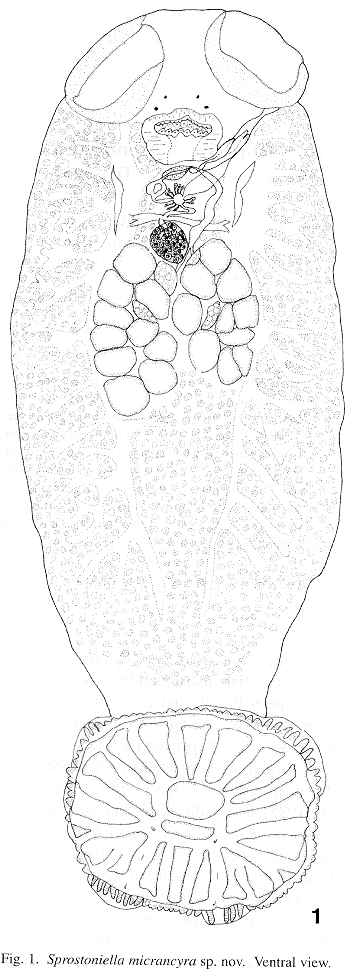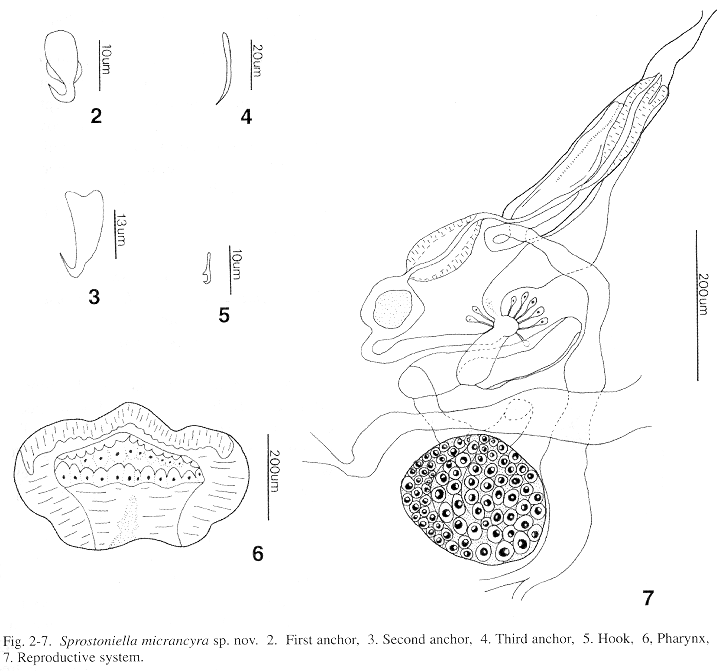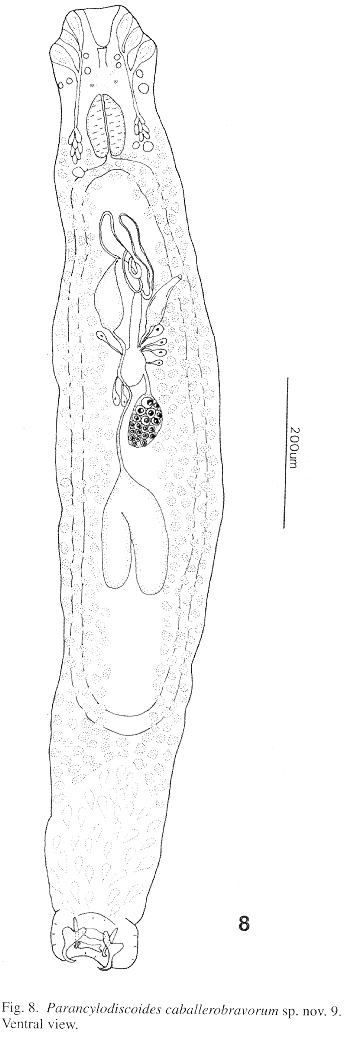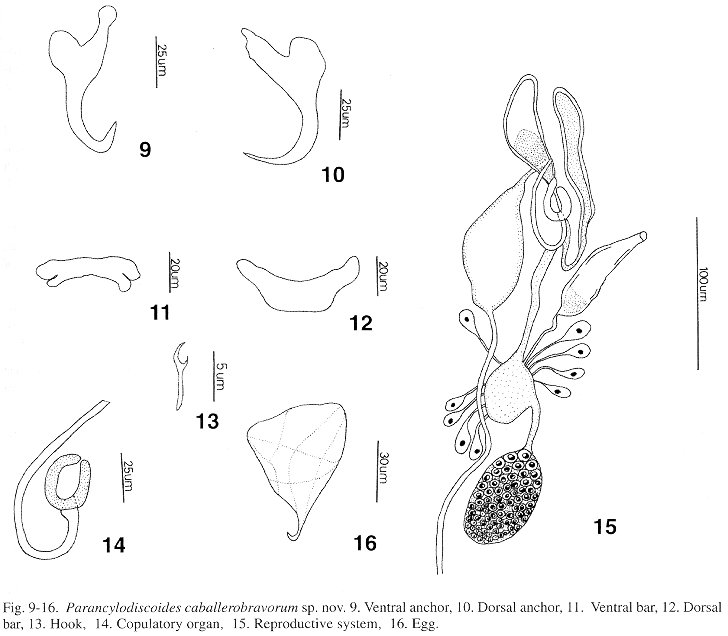Services on Demand
Journal
Article
Indicators
-
 Cited by SciELO
Cited by SciELO -
 Access statistics
Access statistics
Related links
-
 Similars in
SciELO
Similars in
SciELO  uBio
uBio
Share
Revista de Biología Tropical
On-line version ISSN 0034-7744Print version ISSN 0034-7744
Rev. biol. trop vol.47 n.3 San José Sep. 1999
Abstract
Metazoan parasites were extracted for 110 Chaetodipterus faber (Broussonet, 1782) (Teleostei: Ephippidae) specimens from the coastal zone of the State of Rio de Janeiro, Brazil (nearly 21-23º S, 41-45º W). Two new species of monogeneans belonging to genera Sprostoniella and Parancylodiscoides are described and illustrated. The new species of Sprostoniella, differ from S. multitestis, the only known species of the genus, by: 1. the arrangement of septa (with 17 septa, two of them bifid and two incomplet in the new species; 17 septa, two of them trifid in S. multitestis). 2. the new species showed two central loculi, while S. multitestis only one, and 3. the first pair of anchors of the new species is small and poorly developed, while in S. multitestis is well developed and strong. The new species of Parancylodiscoides differs from P. chaetodipteri, the only known species of the genus, by: 1. the testis shape (bilobated in the new species, not bilobated in P. chaetodipteri), and 2. by the presence of accessory prostatic reservoir at the copulatory organ base (absent in P. chaetodipteri).
Key words
Monogenea, Sprostoniella, Parancylodiscoides, new species, Chaetodipterus faber, Brazil.
Chaetodipterus faber (Broussonet, 1782) is a benthic fish distributed from New England to southern Brazil, and common in the southern Brazilian coastal zone (Menezes & Figueiredo 1985). Papers on parasites of C. faber from Brazil are restricted to some records of digenean species: Kohn (1966), Fernandes et al. (1985), and Wallet & Kohn (1987) recorded digenean parasites of C. faber from the State of Rio de Janeiro; and Amato (1982, 1983a, b) from Florianópolis, State of Santa Catarina.
During a parasitological survey of marine fishes from the coastal zone of the State of Rio de Janeiro, were necropsied 110 specimens of C. faber and collected numerous metazoan parasites. In the present paper two new species of polyonchoinean monogeneans are described and illustrated.
Materials and methods
The monogeneans studied are part of the material collected from 110 specimens of C. faber from the coastal zone of the State of Rio de Janeiro, Brazil (21-23ºS, 41-45ºW) during 1995-1996. Specimens of C. faber were identified according to Menezes & Figueiredo (1985). The fishes measured 14.0 – 46.0 cm (27.7 ± 7.1 cm) of total length, and weighted 150 - 2430 g (817.5 ± 462.8 g). All the monogeneans were fixed in A.F.A., preserved in ethanol 70°GL, stained with Gomoris trichrome, and mounted in Canada balsam. Measurements were made in micrometers (*m), unless otherwise stated, the range is followed by the mean within parentheses. The terms prevalence, mean intensity and mean abundance were used according to Bush et al. (1997). Holotypes and paratypes were deposited in the Coleção Helmintológica do Instituto Oswaldo Cruz (CHIOC), Rio de Janeiro, Brazil. Also, some paratypes were deposited in the Colección Nacional de Helmintos, Instituto de Biologia, Universidad Nacional Autónoma de México (CNHE).
Results
Description (based on 18 whole-mount, all measured): Body 3.2 – 8.3 mm (6.3 mm) in total length, elliptical (Fig. 1); greatest width 1.1 – 2.7 mm (2.2 mm) in germarian level. Four eyes with trapezoidal arrangement. Haptor 1.3 mm – 2.2 (1.6 mm) in diameter, with peripheral papilliform ornamentation, pedunculated, concave; with 17 septa, two of them bifid, and other two incomplete; two central loculi of unequal size. Three pairs of diminute anchors, first pair 31 (n=3) long, second pair 27.5 (n=3) long, third pair 25.6 – 36.6 (31.6, n=4) long (Figs. 2-4). Fourteen peripheral hooks (Fig. 5) 6.2 (n=6) long. Buccal organs 274 - 640 (426) long, 366 - 421 (522) wide; pharynx (Fig. 6) 219 - 540 (500) long, 275 - 603 (461) wide, with internal papillae; intestinal ceca not confluent posteriorly, with ramifications. Testes, 146.4 - 348 (256, n=13) in diameter, in two groups, left group with 8-10 testes, right group with 9-10 testes. Four conspicuous Gotos glands 109 - 146 (127, n=6) long, 43.8 - 51 (47, n=13) wide. Penis pouch (Fig. 7) 175 - 292 (235, n=10) long, 51 - 131 (84, n=10) wide, posterior to pharynx; oblique, genital atrium opened to left of pharynx. Germarium oval, 164 - 495 (365) in diameter, pretesticular; short uterus; vagina long, with distal papilliform structure (Fig. 7); two seminal receptacles; vitellaria limited in trunk.


Etymology: The specific name is from Greek (mikrós = small + agkyra = anchor) and refers to diminute size of the first pair of anchors.
Type host: Chaetodipterus faber (Broussonet, 1782).
Type locality: coastal zone of the State of Rio de Janeiro, Brazil.
Site of infestation: gills.
Type material: Holotype CHIOC N°34000a, paratypes (three whole-mount) CHIOC N°34000b, (three whole-mount) CNHE N°3431.
Prevalence: 8.2 %.
Mean intensity: 1.2.
Mean abundance: 0.1.
Remarks: Bychowsky & Nagibina (1967) established Sprostoniella with the type species S. multitestis parasitic on Platax pinnatus (L.). Diagnostic characters of this genus are the two neighbouring groups of testes, and the structure of loculi of the haptor. These characters were confirmed by Ergorova (1994) in her revision of Trochopodinae. Sprostoniella micrancyra sp. nov., differ from S. multitestis by the arrangement of septa (with 17 septa, two of them bifid and two incomplet in the new species; 17 septa, two of them trifid in S. multitestis). Moreover, the new species showed two central loculi, while S. multitestis only one. In the new species the first pair of anchors is small and poorly developed, while in S. multitestis is well developed and strong.
Description (based on 15 whole-mount, 10 measured): Body elongate (Fig. 8), peduncle with conspicuous glandular area. Total length 1.35 – 1.42 mm (1.40 mm), greatest width 221 - 239 (230) to germarium level. Cephalic region 82 - 94 (88) long, 143 - 148 (146) wide; with three cephalic lobes. Eye spots dispersed. Haptor 89 - 94 (92) long, 157 - 176 (165) wide; anchors subequal, ventral anchors (Fig. 9) 40 - 41 (40) long, 12 - 14 (13) wide; dorsal anchors (Fig. 10) 30 - 33 (32) long, 11 - 12 (12) wide, with curved shaft and point; ventral bar (Fig. 11) 7 - 16 (12) long, 42 - 52 (48) wide, with lateral bifid, round, extremities; dorsal bar (Fig. 12) 12 - 16 (15) long, 52 - 61 (57) wide, with lateral folded extremities. Ten equal hooks (Fig. 13) 6-8 (7) long, with long shank, curved shaft, and delicate point; FH loop not observed. Mouth subterminal; pharynx pyriform 70 - 94 (85) long, 56 - 59 (58) wide; intestinal ceca confluent posteriorly. Testis bilobate, 117 - 188 (141) long, 94 - 118 (106) wide; deferent duct long, not overlooped intestinal ceca; seminal vesicle 117 - 141 (133) long, 61 - 70 (67) wide, prostatic and accessory reservoirs well developed; sclerotized copulatory organ (Fig. 14), 16 - 28 (22) long, 12 wide, with ejaculatory bulb. Germarium 56 - 59 (57) in diameter, ovoid, pretesticular; Mehliss gland with elongate radial cells; vaginal aperture ventrolateral (Fig. 15); vitellaria limited in trunk; eggs (Fig. 16) 59 (n=1) long, 12 (n=1) wide, tetragonal, short posterior filament.


Etymology: The specific name is in honor to Dr. Eduardo Caballero y Caballero and Dr. Margarita Bravo Hollis (Universidad Nacional Autónoma de México) who established Parancylodiscoides.
Type host: Chaetodipterus faber (Broussonet, 1782).
Type locality: coastal zone of the State of Rio de Janeiro, Brazil.
Site of infestation: gill filaments.
Type material: Holotype CHIOC N°, paratypes (three whole-mount) CHIOC N°, (three whole-mount) CNHE N° 3432.
Material examined: Three paratypes of Parancylodiscoides chaetodipteri Caballero & Bravo-Hollis, 1960; CNHE N° N-217-20.
Prevalence: 21.8 %.
Mean intensity: 6.9.
Mean abundance: 1.5.
Remarks: Caballero & Bravo-Hollis (1960) established Parancylodiscoides, with the type species P. chaetodipteri, parasitic on gills of Chaetodipterus zonatus (Girard) from the coastal zone of the Mexican Pacific Ocean. Yamaguti (1963) proposed Parancylodiscoides as junior synonym of Pseudohaliotrematoides (Yamaguti, 1953), emending the subgenus status to genus level. Young (1967) in his revision of some species of Tetrancistrum, validity Parancylodiscoides, based in the structure of the intestine and by the variability of other characters in Pseudohaliotrematoides.
Parancylodiscoides caballerobravorum sp. nov. differ from P. chaetodipteri Caballero & Bravo-Hollis, 1960 by the testis shape (bilobated in the new species, not bilobated in P. chaetodipteri), and by the presence of accessory prostatic reservoir reaching at the copulatory organ base (absent in P. chaetodipteri).
Acknowledgements
We thank Rafael Lamothe Argumedo (Colección Nacional de Helmintos, Instituto de Biologia de la Universidad Nacional Autónoma de México) for loaning paratypes of Parancylodiscoides chaetodipteri, Delane Kritsky (Idaho State University) for providing Russian literature, José R. Pujol-Luz (Universidade Federal Rural do Rio de Janeiro) for the suggestions on the Sprostoniella specific name. The authors are also grateful to Conselho Nacional de Desenvolvimento Científico e Tecnológico (CNPq) for support.
Se extrajeron metazoos parásitos de 110 Chaetodipterus faber (Broussonet, 1782) (Teleostei: Ephippidae) del litoral del Estado de Rio de Janeiro, Brasil (aprox. 21-23º S, 41-45º W). Se describe e ilustra dos nuevas especies de monogéneos de los géneros Sprostoniella y Parancylodiscoides. La nueva especie de Sprostoniella difiere de S. multitestis, la otra especie del género, por 1. la disposición de los septos (con 17 septos, dos de ellos bífidos y dos incompletos en la nueva especie; 17 septos, dos de ellos trífidos en S. multitestis), 2. la nueva especie muestra dos lóculos centrales, mientras S. multitestis sólo uno, y 3. el primer par de ganchos en la nueva especie es pequeño y poco desarrollado, mientras que en S. multitestis es robusto y bien desarrollado. La nueva especie de Parancylodiscoides difiere de P. chaetodipteri, la otra especie del género, por 1. la forma del testículo (bilobulado en la nueva especie, no bilobulado en P. chaetodipteri), y 2. por la presencia de un reservorio prostático accesorio que alcanza la base del órgano copulador (ausente en P. chaetodipteri).
References
Amato, J. F. R. 1982. Digenetic Trematodes of Percoid fishes of Florianópolis, Southern Brasil - Monorchiidae, with the description of two new species. Rev. Brasil. Biol. 42: 701-719. [ Links ]
Amato, J. F. R. 1983a. Digenetic trematodes of Percoid fishes of Florianópolis, southern Brasil - Homalometridae, Lepocreadiidae and Opecoelidae, with the description of seven new species. Rev. Brasil. Biol. 43: 73-98. [ Links ]
Amato, J. F. R. 1983b. Digenetic trematodes of Percoid fishes of Florianópolis, southern Brasil - Pleorchiidae, Didymozoidae and Hemiuridae, with description of three new species. Rev. Brasil. Biol. 43: 99-124. [ Links ]
Bush, J. O., K. D. Lafferty, J. M. Lotz & A. W. Shostak. 1997. Parasitology meets ecology on its own terms: Margolis et al. revisited. J. Parasitol. 83: 575-583. [ Links ]
Bychowsky, B. & L. Nagibina. 1967. New Capsalidae (Monogenoidea) from Pacific fishes. Parasitologiya 1: 521-527. (In Russian). [ Links ]
Caballero, E. & M. Bravo-Hollis. 1960. Trematodos de peces de aguas Mexicanas del Pacífico. Un nuevo género y una nueva especie de Monogenoidea Bychowsky, 1937. An. Inst. Biol. Univ. Nac. Autón. Méx. 30: 197-205. [ Links ]
Ergorova, T. P. 1994. A taxonomic review of the subfamily Trochopodinae (Monogenoidea: Capsalidae). Parasitologiya 28: 81-91. (In Russian). [ Links ]
Fernándes, B. M. M., A. Kohn & R. Pinto. 1985. Aspidogastrid and digenetic trematodes parasites of marine fishes of the coast of Rio de Janeiro State, Brazil. Rev. Brasil. Biol. 45: 109-116. [ Links ]
Kohn, A. 1966. Ocorrência de Multitestis inconstans (Linton, 1905) Manter, 1931 (Lepocreadiidae) no litoral brasileiro. Atas Soc. Biol. Rio de Janeiro 10: 75-77. [ Links ]
Menezes, N. A. & J. L. Figueiredo. 1985. Manual de peixes marinhos do Sudeste do Brasil. V. Teleostei (4). Museu de Zoologia da Universidade de São Paulo, São Paulo, 105 p. [ Links ]
Wallet, M. & A. Kohn. 1987. Trematodes parasites de Poissons marins du littoral de Rio de Janeiro, Brésil. Mem. Inst. Oswaldo Cruz 82: 21-27. [ Links ]
Yamaguti, S. 1963. Systema Helminthum. Vol. IV. Monogenea & Aspidocotylea. John Wiley & Sons, New York, 699 p. [ Links ]
Young, P. C. 1967. Some species of the genus Tetrancistrum Goto and Kikuchi, 1917 (Monogenoidea: Dactylogyridae). J. Parasitol. 53: 1016-1022. [ Links ]
1. Departamento de Parasitologia Animal - Curso de Pós-Graduação em Medicina Veterinária - Parasitologia Veterinária, Universidade Federal Rural do Rio de Janeiro, CP. 74508, Seropédica, RJ, Brasil, 23890-000. Fax: (021) 6821617.
2. Departamento de Zoologia, Universidade Federal do Rio Grande do Sul, Porto Alegre, RS, Brasil.
3. Corresponding author. E-mail: acezar@domain.com.br














